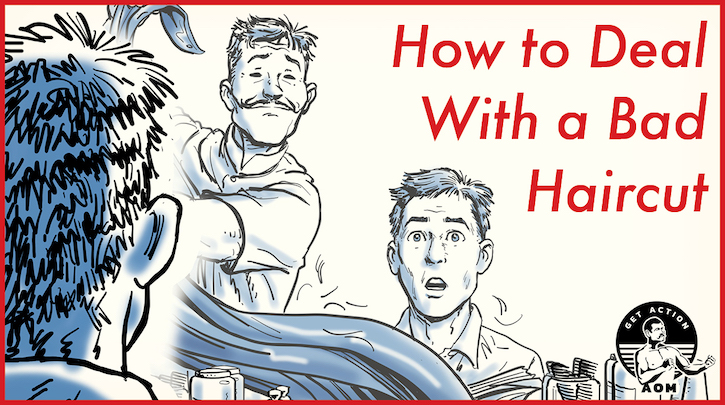
Picture this. You’re at the barbershop. Your barber takes a few final snips to clean up some stray hairs around your ear line. He takes off your cape and swivels your chair around so you’re facing the mirror. Then he holds a handheld mirror up behind you so you can see the back of your head.
With a big smile on his face, the barber asks, “So what do you think?”
What you think is that it’s a terrible haircut. The worst one you’ve ever gotten in your life. You’re going to have to walk around with a paper bag over your head like Charlie Brown.
But instead of saying that, you mumble “It’s fine,” swipe your card to pay (even adding a tip for the butchering, cuz you’re such a nice guy), and walk out the door.
There’s a better way to handle getting a bad haircut. And to learn what that is, I talked to my barber, Thad Forrester, co-owner of Hudson / Hawk Barber & Shop (locations in KS, AR, and MO). Here’s what he told me.
Prevent a Bad Haircut From Happening in the First Place
The best way to manage a bad haircut is to avoid getting one in the first place. An ounce of prevention is worth a pound of cure and all that jazz.
Thad recommends that before your barber gets anywhere close to your head with a pair of clippers, you do a thorough consultation with him or her about your expectations — especially if this is the first time that they’ll be cutting your hair or you’re changing your usual style. “If your barber skips this step,” Thad says, “it might be time to look for a different one.”
This pre-cut consultation should be a two-way conversation; not only should you fill in your barber about what you’re looking for, Thad says a good barber or stylist should ask you the following questions:
How long has it been since your last haircut? Is this normally how long you go between cuts? (Gives the barber an idea of how much length to take off.)Are you wanting to stick with the same basic style or are you looking to change it up? (During this time, the barber should also be combing through your hair, looking for any bumps, potential problem areas, difficult growth patterns, etc.)How much time do you spend styling your hair? or What’s your morning hair styling routine look like? (Gives the barber insight into whether you blow-dry, use product, etc., allowing him to recommend an appropriate look or recommend a different style.)What do you like about your current hairstyle? Is there anything you don’t like or would like to change? Any areas of your hair that give you issues? (Lets the barber know areas that you’re particularly sensitive to, such as a difficult swirl in the back that sticks up if it gets too short, ect.)Clear communication with your barber will go a long way in preventing a bad haircut from happening and ensuring you get a final result you’re happy with. Make sure to read our guide on how to talk to your barber so that you’re on the same page with him.
Be Assertive and Speak Up During Your Haircut
According to Thad, a good barber will check in with you periodically during the cut to make sure he’s cutting your hair in accordance with your desires. Again, this is especially true if this is the first time he’s cutting your hair or you’re changing up the way you normally get your hair cut.
When your barber asks you these in-progress questions, be honest. Don’t just mumble your assent because you’re shy/passive.
If your barber doesn’t check in with you during the cut, be assertive (which doesn’t have to mean jerky) and speak up when you see him doing something you don’t like. If he’s cutting your sides too short, let him know right away. He might be able to course correct a bit. Even if he can’t, it’s feedback for him to use next time.
What to Do When Your Haircut Is Finished, and It’s Still Bad
Let’s say you did all of the above, and you’re still not happy with your haircut when the barber does the final reveal and asks you how it looks.
Thad says to be honest: “If there’s an area you see that needs to be addressed, tell your barber and ask if there’s anything he can do to correct it. A good barber wants honest feedback and won’t get offended. We want to keep polishing our skillset.” A good barber wants you to leave his chair completely happy with your haircut.
To correct a cut, usually you’ll need to go shorter.
No comments:
Post a Comment